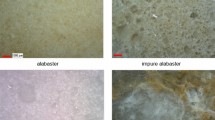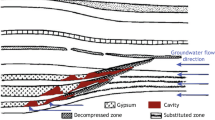Abstract.
In order to gain a clearer understanding of the decay mechanisms operating in limestones, and to determine the main damage factors at different exposure environments, calcite-dissolution models from the literature were compared. The models recognise three major stone decay mechanisms: attack by air pollutants (dry deposition), dissolution in clean rain (karst effect) and dissolution caused by neutralisation of rain acidity (acidity effect). These models were fitted to experimental data obtained from the run-off water analysis running over the so-called Massangis limestone, exposed under ambient conditions in five sites in Belgium. The models demonstrate that different processes dominate the limestone dissolution at the different sites, with dry deposition of air pollutants (especially SO2) being the principal process involved.
Similar content being viewed by others
Author information
Authors and Affiliations
Additional information
Electronic Publication
Rights and permissions
About this article
Cite this article
Cardell-Fernández, .C., Vleugels, .G., Torfs, .K. et al. The processes dominating Ca dissolution of limestone when exposed to ambient atmospheric conditions as determined by comparing dissolution models. Env Geol 43, 160–171 (2002). https://doi.org/10.1007/s00254-002-0640-x
Received:
Accepted:
Issue Date:
DOI: https://doi.org/10.1007/s00254-002-0640-x




